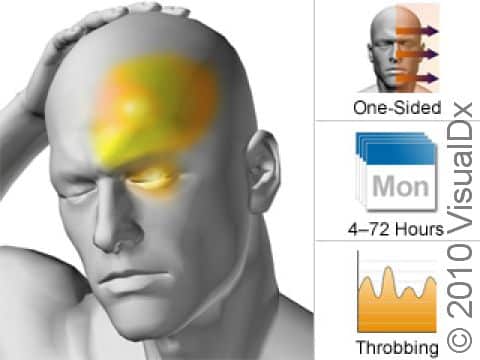Migraine Headache
A migraine is a set of symptoms that usually includes headache as the main complaint. Migraine headaches are usually severe, affecting one side of the head. Most people with a migraine have vision changes such as sensitivity to light, sensitivity to sound, and nausea. In about 1 in 5 people, migraines involve a warning, called aura. A small number of people get aura without headache, which is known as ocular or retinal migraine.
Common triggers for migraine include hormonal changes, sleep issues, weather changes, stress, not eating enough, certain foods, and certain medications.
Who's At Risk?
- Migraines are fairly common, affecting up to 17% of women and 6% of men.
- Migraines tend to run in families.
- Migraines can occur in children, but they most commonly affect older people, generally starting between ages 15-25 years.
- Migraines often occur throughout a person’s life, but migraine attacks sometimes stop in late adulthood.
- There is a type of migraine that starts after age 50.
- For many women, migraines occur in a monthly pattern related to their menstrual cycle.
Signs & Symptoms
Headache is the most common symptom associated with migraine, and severe, sharp, and often throbbing pain is usually felt on one side of the head. There may be aura prior to the headache, beginning hours to minutes before the pain. Aura often includes changes in vision, which may appear as flashing lights or shimmering. It may be difficult to see through these vision changes, which often start 10-15 minutes before the head pain. These vision changes usually stop when the headache starts. Some people notice a change in personality before their migraine headache. They may be distractible, irritable, or feel like they are “not themselves” for several hours before the migraine.
During a migraine, the person may feel nauseated and may even vomit. The person often feels sensitivity to light and sound. They may have weakness in an arm or leg or may lose sensation in their limbs.
Although a migraine headache is usually moderate to severe, some people are most bothered by the other associated symptoms, such as aura, light sensitivity, or nausea.
A migraine can last for several hours but often goes away after sleeping through the night. Following a migraine, many people feel drained, have a dull headache, and describe this stage as a “migraine hangover.”
Self-Care Guidelines
During the migraine:
- Acetaminophen, ibuprofen, and other over-the-counter pain relievers may be helpful.
- Some migraines respond well to caffeine, so a couple cups of coffee may help stop migraine in some people. Some over-the-counter headache remedies also have caffeine in them (eg, Excedrin Migraine). Note, however, that caffeine is a common migraine trigger for others.
- Rest, quiet, and avoiding light and noise can help during a migraine.
To prevent migraine attacks:
- Avoid foods and beverages that may trigger migraines. Common causes include red wine, cheese, nuts, foods with nitrates or nitrites (eg, preserved meats), caffeine, and artificial sweeteners. Keeping a headache diary to compare the foods you have eaten with the days that you have a migraine may help.
- Practice relaxation techniques.
Treatments
There are 2 types of medications that are typically prescribed for treating migraines:
- Abortive medications, which aim to stop the headache once it has started.
- Preventive or prophylactic medications, which aim to prevent headaches.
Abortive medications
Aspirin and ibuprofen can be effective abortive medications for migraines, but a more commonly used type of abortive treatment is called the “triptans.” These include sumatriptan (Imitrex), rizatriptan (Maxalt), and similar medicines. To be most effective, abortive medications should be taken as soon as possible after the headache begins. One concern with abortive medications is that they may create a cycle of return of the headache, or rebound, once the medication has worn off.
Preventive medications
Certain kinds of blood pressure medications, antidepressants, and anticonvulsants have been found to be effective preventive medications. These medications are taken every day, whether a headache occurs or not.
Visit Urgency
Seek medical care if:
- It is the first time you have ever had symptoms of migraine.
- You experience a sudden severe headache.
- You have a headache and feel disoriented, confused, lose consciousness, or have a seizure.
- A severe headache occurs during intense effort (eg, lifting something heavy, bearing down during a bowel movement, or during intercourse).
- You have a new or worsening headache and you are older than 50.
- You have a new headache in addition to an infection.
- Your headache lasts for several days.
- You are dehydrated due to nausea and vomiting.
- You have headaches that get worse in severity or occur more often.
Immediately seek medical care if you or someone you are caring for experiences:
- A stiff neck and high fever with a headache.
- Loss of motor function (eg, your muscles don’t move normally), inability to think clearly, or convulsions with a headache.
- A head injury.
Last modified on October 7th, 2024 at 1:28 pm

Not sure what to look for?
Try our new Rash and Skin Condition Finder
